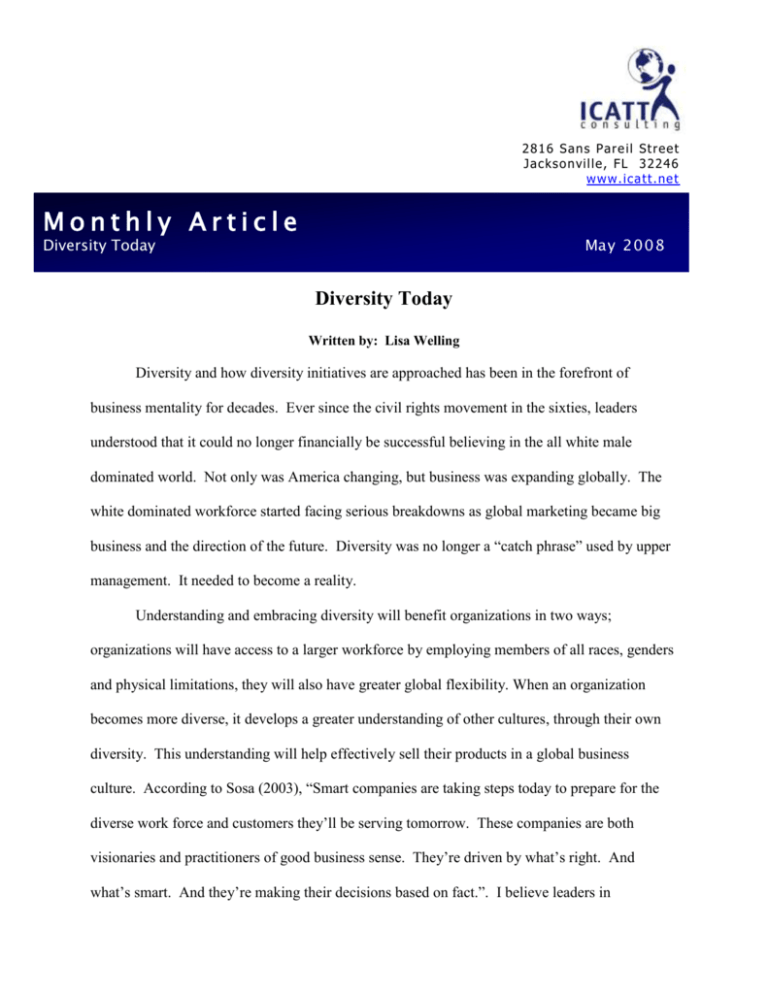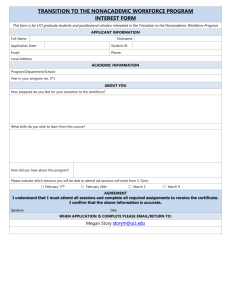
2 81 6 S a n s Pa re il St ree t
Ja c ks o n vil le, FL 3 2 24 6
www. ica tt. ne t
Monthly Article
Diversity Today
May 2008
Diversity Today
Written by: Lisa Welling
Diversity and how diversity initiatives are approached has been in the forefront of
business mentality for decades. Ever since the civil rights movement in the sixties, leaders
understood that it could no longer financially be successful believing in the all white male
dominated world. Not only was America changing, but business was expanding globally. The
white dominated workforce started facing serious breakdowns as global marketing became big
business and the direction of the future. Diversity was no longer a “catch phrase” used by upper
management. It needed to become a reality.
Understanding and embracing diversity will benefit organizations in two ways;
organizations will have access to a larger workforce by employing members of all races, genders
and physical limitations, they will also have greater global flexibility. When an organization
becomes more diverse, it develops a greater understanding of other cultures, through their own
diversity. This understanding will help effectively sell their products in a global business
culture. According to Sosa (2003), “Smart companies are taking steps today to prepare for the
diverse work force and customers they’ll be serving tomorrow. These companies are both
visionaries and practitioners of good business sense. They’re driven by what’s right. And
what’s smart. And they’re making their decisions based on fact.”. I believe leaders in
organizations today finally understand the incredible significance of employing a diverse
workforce to serve a diverse customer base.
Historically, diversity has been seen as a white/black issue, primarily driven by the civil
rights movement of the sixties. The approach organizations have taken in the past has been
mainly to understand the black/white disconnect. However, since that time, there has been an
interesting shift in the diversity landscape in America. America is experiencing a tremendous
population shift towards Hispanics and Asians. From an American labor perspective, diversity
can no longer be a two dimensional approach. Organizations need to move outside their
paradigms and realize that the term “diversity” goes far beyond the color of a person’s skin.
Diversity is the term used to define all things different from ourselves.
Race/Gender projections for the workforce in the year 2020
80%
70%
60%
White male
50%
Women
40%
Hispanic
30%
Black
20%
Asian
10%
0%
1995
2005
2020
Source: Workforce 2020, Hudson Institute
It is interesting to note from the above graphic that the populations in the workforce that
steadily increases are the populations of Women, Blacks, Hispanics and Asians. The white male
population will slowly decrease. The women and black community see a slight increase over the
next 15 years. However, the increase is not nearly as significant as the Hispanics and Asians.
So, as I stated before, diversity needs to go beyond the two dimensional perspective of white and
black.
Generational Issues
Diversity goes beyond race and gender. It also includes age. Many problems can arise
when people who work together are from different age generations. It is no mystery that people
from different age groups see things differently.
We are quickly approaching one of the most dramatic workforce shifts in American
history. As the baby boomers start transitioning out of the workforce, there will be greater
opportunities for the youth to seek careers in many organizations. According to Diversity Today,
“With 77 million baby boomers approaching retirement age, the overpopulated workforce of the
20th century is disappearing…” (p. S2) However, during this transition period, which will take
several years, young and old will need to find common ground in the midst of their age diversity
to be productive on the job.
There are currently four different age generations working together in today’s workforce:
Traditionalists, born between 1900 and 1945; Baby Boomers born between 1946 and 1964;
Generation X born between 1965 and 1977; and Generation Y born between 1978 and 1994.
(Mayo Clinic Working Life Center, 2005) Each of these generations has very different
perspectives on work ethics. According to the Mayo Clinic Working Life Center, “Traditionalists
are loyal, hardworking, financially conservative and faithful to institutions.” The traditionalist’s
are the backbone of our industrial age. In essence, their hard work built our prosperous
economic society. The traditionalist’s never dreamed of leaving their employer, let alone
expected to be fired. The Baby Boomers, “…all but invented the 60-hour workweek, figuring
that demonstrated hard work and loyalty…Their sense of who they are is deeply connected to
their career achievements.” Baby Boomers had to compete to find jobs, because there were so
many people entering the workforce at the same time. Because of this, many worked long hours
to show their commitment to their employers. Generation X has a completely different
approach, “…Gen X style of blurring the boundaries between the workplace and the home,
between the personal and professional, fits well with the needs of the millennial corporation.”
Generation X wants to find the healthy balance between professional and personal lives. No
longer are organizations loyal to employees nor employees loyal to organizations, those days are
gone. Generation X wants to work, but strike a healthy balance. As for Generation Y, “At 60
million strong…they’re the biggest thing to hit the American scene since the baby
boomers…This generation is more racially diverse.” (2005). It is still early to tell how this
generation will face their working lives, but there is speculation that it will be a continued
philosophy of the Generation X.
All four generations bring very different diverse working perspectives to their work lives.
Add to that, many of the younger employees are now managing the older employees. Both of
these variables can bring about diversity conflicts. However, these diverse perspectives can
bring incredible opportunities for learning, if the organization embraces those differences.
Global Workforce and Marketplace
In order for companies to be successful in increasing a global marketplace and diverse
workforce, they will need to revisit how and what they offer potential employees. “A reputation
for inclusiveness enhances a firm’s image as “the employer of choice.” Competitive salaries and
standard benefit packages, complemented by increased workplace flexibility (flextime, job
sharing, telecommuting), training, balanced work-life initiatives, mentoring and networking
opportunities, high school and college outreach programs, and child care and elder care are some
of the factors attracting the best talent and keeping it.” (Diversity Today, p.S2) As it becomes
harder for organizations to find qualified candidates, the competition for quality employees will
increase. Organizations will need to have the best package to lure those competent employees in
the door.
Obviously, it is advantageous to employ a diverse workforce for many reasons, but the
primary reason will be the customer. Organizations have growing diversity among their
customer base as business expands globally. It is vital to understand a customer’s perspective
and what better way than to embrace diversity within the organization. When an organization
actively recruits a diverse employment base, the culture of the organization changes. It provides
learning opportunities that can be applied to the customers the organization serves. Diversity
Today noted, “An inclusive workforce can also help find solutions to a different marketing
challenge – how to market in a way that targets specific consumer groups…” (p.S4)
Ultimately, companies around the global are looking to be financially successful, no
matter what their area of expertise. It is all about financial success. To be financially successful,
companies need to understand their customer. As stated in Diversity Today, “With AfricanAmericans, Asian-Americans, and Hispanics in possession of more than $650 billion in annual
spending power, a diverse workforce can provide the requisite cultural perspective to reach these
targeted markets.” (p. S4)
Conclusion
Unfortunately, we live in a society where terms like, diversity training, affirmative action,
and accepting differences all have negative connotations. There was a very ugly time in the not
so distant past that diversity, especially diversity training, took the approach of “shut up and like
it.” It was clearly delivered to the American workforce as you have to deal with it and accept it,
no matter what. It was also clear that diversity training tended to take an aggressive approach.
Instead of creating a greater understanding of fellow human beings, it created more animosity
and tension than there was before the training. It created a greater divide.
Thankfully, there has been a shift in diversity training and the approach. The key theme
in today’s training programs is embracing diversity and everyone’s differences. No longer is the
training force fed or meant to create tension. The sole purpose is to create opportunities for
understanding. It is about respecting humanity and all that the positive side of humanity
represents.
References
Osland, K., & Rubin, T. (2007). Organizational Behavior An Experiential Approach. Upper
Saddle River, New Jersey: Pearson Prentice Hall.
Diversity Central: Resources for Cultural Diversity at Work. Workforce 2020, Hudson Institute.
Retrieved May 4, 2008 from:
http://www.diversitycentral.com/business/diversity_statistics.html#entrants
Sosa, L. (2003). Embracing Diversity Today Will Pay Off Tomorrow. [Electronic Version]
Houston Business Journal. Retrieved May 4, 2008, from:
http://www.bizjournals.com/houston/stories/2003/08/11/editorial3.html
Tulgan, B. Managing Generation X: How to bring out the best in young talent. WW Norto and
Company, Inc. New York, NY. 2000.
Mayo Clinic Working Life Center. “Workplace Generation Gap: Understanding differences
among colleagues” July 6, 2005.
http://www.mayoclinic.com/health/working-life/WL00045
Society for Human Resource Management. Diversity Today. Corporate Recruiting Creates
Inclusive Workplaces. Retrieved May 4, 2008 from:
http://www.shrm.org/diversity/members/0600Diversity.pdf








